One of the traits that I notice about Post Modern Art, meaning art ranging from the 1980’s clear to the present day, is that the art forms gaining popularity seem to be much more interactive than in eras past. Deconstruction Art, Installment Art, Street Art, Performance Art, and Public Sculptures are all much more inviting to be interacted with than the typical painting or photograph, which is displayed in an exhibit, often in a glass display case, with an expected viewing distance between you and the piece.
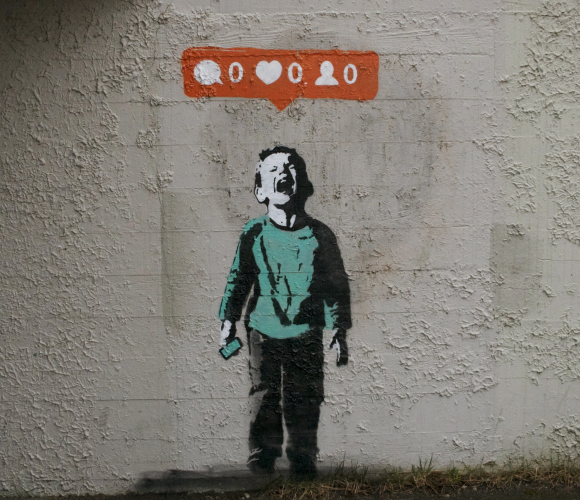
“Nobody Likes Me,” by artist iHeart (Feb. 2014) and made popular largely thanks to the shout out that Banksy gave the Vancouver artist, was named the second most popular street art of 2014 in Canada. (Metronews Canada) What I like about this piece in particular is not only the simplicity of the piece, it takes up a very small portion of it’s canvas and emphasis the empty space surrounding it, but the homage it pays to today’s society. The statement the piece makes is very simple – people are driven by their social media perception rather than by real, tangible life around them.
These modern street art pieces by artists like Banksy and iHeart use their large audience to make very poignant, well-timed, and often political statements. Unlike popular artists of the past, artists like this often work very hard to maintain their anonymity rather than signing their name to their piece – or coming up with an alias, so that your pieces are still recognizable.
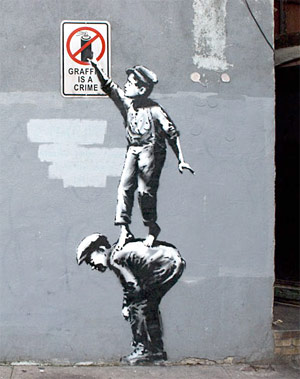
Banksy’s “Graffiti is a Crime,” from October of 2013, while sassy as can be, plainly illustrates why these artists may choose to hide their identity. Street art, as appreciated as it may be by the masses and especially by the internet, is still considered vandalism and is liable to be punished by the law.
Both Banksy and iHeart not only share the fact that they prefer street art to more traditional styles, they also both stick to stencils for these pieces. Also like iHeart’s piece, “Nobody Likes me,” Banksy’s pieces makes masterful use of it’s shading and shadows as well as the blank space around it. Due to Banksy’s tendency to make pointed, argumentative statements with his art that challenge the status quo, I would venture to guess that this is his response to his art being considered illegal.
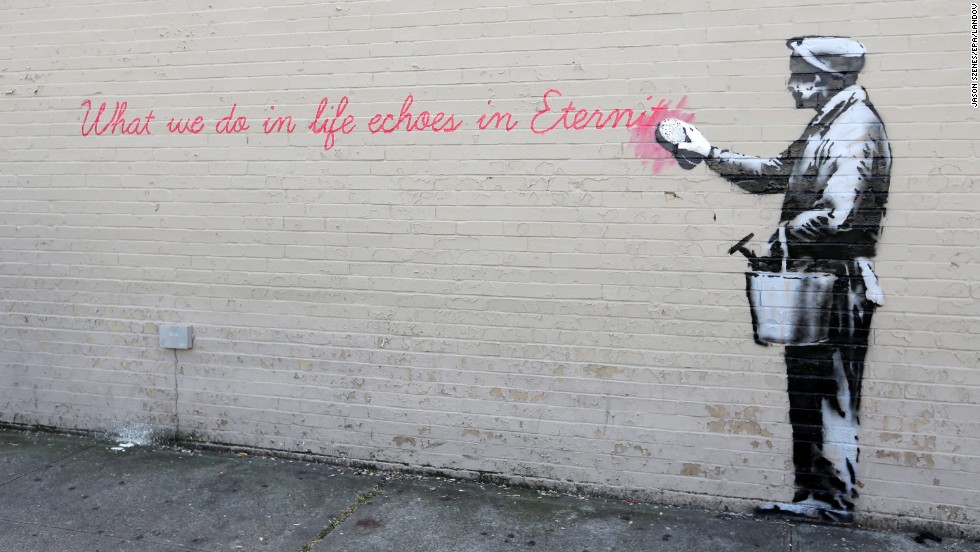
Though illegal, Banksy’s art pieces are interactive not only via modern politics, but also directly with his fans and audience. Created in October of 2013, this piece was Banksy’s first in Queens, New York, and was supposedly in direct response to being asked to inspire an instagram follower’s son. (Untapped Cities)
I’d also like to think that the man tasked with cleaning the writing off of the wall that is pictured on the right hand side of this installment is a bit of a jab in itself. Possibly once more drawing attention the futility and asinine nature of outlawing art?
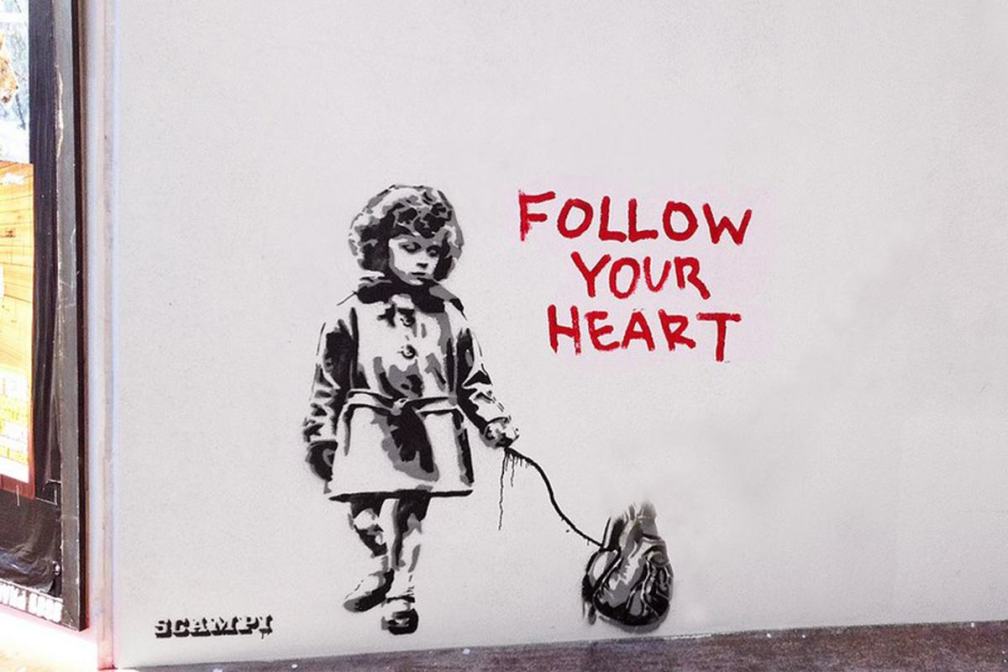
Artist Scampi Wellington from New Zealand put this piece up in January of last year, 2016. This is one of my very favorite pieces of street art that I’ve seen floating around the internet over the past almost two years. Taking a simple saying and giving it a very literal twist is both witty and a bit sassy, and I like the tone that it gives the piece.
The little girl also has a very retro vibe – a large button up shirt, what look to be cute strappy shoes with long tights or socks, something I picture from back in the 90’s. The simple black and white shading of the stencil also add to the aged feeling that the piece exudes. Lastly, his signature in the corner – the bubble letters remind me of the classic style of graffiti that you used to see, before more artistic interpretations and a wider range of subjects began appearing.
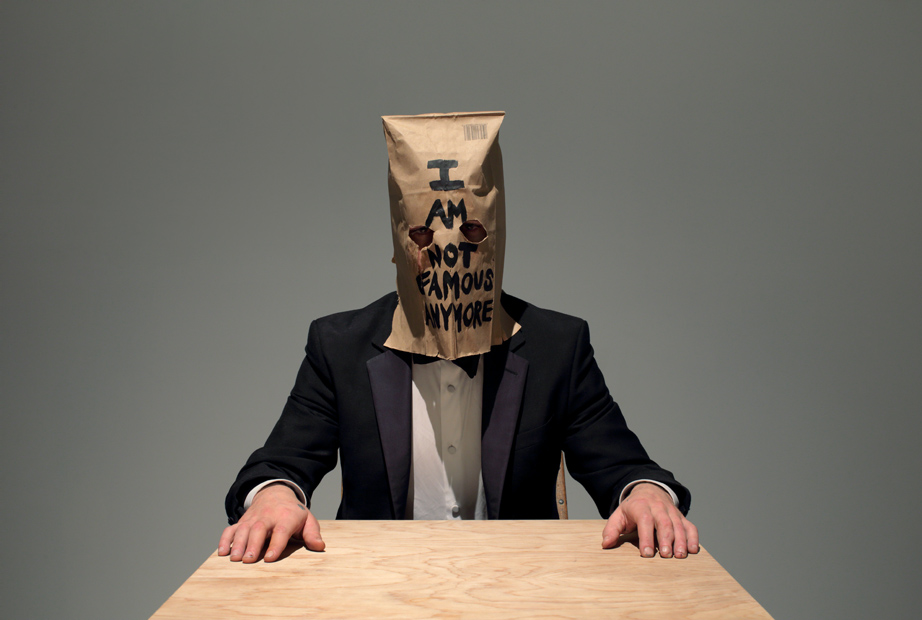
One of the more publicized pieces of performance art that has happened in the past decade, and honestly the only one I had heard of before looking into them, is Shia LaBeouf’s “#IAMSORRY,” from back in February 2014. The piece has been widely criticized and frequently questioned for purpose.
In this exhibit LaBeouf had people patted down, allowed in one at a time, and shown a table full of a fairly random assortment of items, though they all somehow related to and pointed towards his past. They were asked to choose one and then allowed into a room filled with only a simple wooden table, two wooden chairs, and LaBeouf clad in a suit and his paper bag, with “I am not famous anymore” written across it in marker. This piece has garnered LaBeouf a lot of backlash, as many people and most news articles simply credit it to a mental breakdown or childhood stardom catching up with the young LaBeouf. However, others, such as Meta Modernism believe that the piece is a part of a much bigger performance piece.
Either way, you can’t get much more interactive than literally being allowed into a room with the artist and subject of the art piece, and being allowed to do whatever you want.

Possibly one of my favorite forms of modern art is drag! This is Bob the Drag Queen, and while I don’t watch RuPaul’s Drag Race, this is his season 8 “The Signs as Season 8 Queens” look circa 2013.
I feel that drag is an important style of performance art to note because it correlates very directly to the shift in the cultural norm and what is openly and popularly accepted. The 2000’s have been a time for a lot of change, public awareness, and struggles for acceptance for the LGBTQ+ community. I believe the fact that drag became so wildly popular has played, perhaps not a large part, but a notable part, in removing the stigma attached to individuals whom are not cisgender or even those whom simply enjoy exploring their feminine/masculine side in opposite to their typical looks.
Works Cited
Wow! I love the pieces of street art that you have chosen. It is fascinating to see this growing art form in Post Modern art. I have to agree with you that the some of the street art such as “Follow Your Heart” and “Graffiti is a Crime” has a vintage flair, yet I enjoy the vintage aesthetic as it seems to add another layer to the statements that the artists are making. It is fascinating to see these street artists making comments about their art form through their artwork! I was unfamiliar with “#IAMSORRY” until I read your blog. Although Shia LaBeouf’s performance art could be viewed in many different ways, I thought it was making a statement about the Hollywood system. Perhaps the openness of interpretation is the purpose of the “#IAMSORRY.” A street artist whose work I enjoy is Rich Simmons. He does a unique combination of graffiti and canvas art. Simmons also adds a vintage yet modern flair to his artwork by using superheroes and popular topics. Here is the link to Rich Simmons’s website https://www.richsimmonsart.com/
LikeLike
I really like the topic you chose for the Post Modern Era. You bring up a great point about how different interactive art is from previous periods. I think the fact that it is so interactive and so relevant to so many people is what makes it so popular and powerful. What it lacks in artistic pedigree, it makes up for by being interconnected with what is going on in society and making an impact on the viewer. That is what I love about the piece you shared by iHeart titled “Nobody Likes Me.” It is dead on relevant to where society is right now. Just as art in previous eras gave us insight into what was going on in the current socio-political sphere, so does this current art. For example, religious paintings gave insight into the Reformation and now we have pieces like iHeart’s giving insight into the social media, instant gratification, attention craven, technology obsessed culture that we have become.
LikeLike